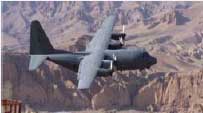C-130 Life Extension
 Project purpose and history
Project purpose and history
The purpose of this project is to upgrade and extend the life of five C-130 Hercules aircraft to 2017, to improve aircraft availability and reliability.
The Government Defence Statement: A Modern, Sustainable Defence Force Matched to New Zealand's Needs (8 May 2001) noted that the C-130 Hercules fleet would be upgraded or replaced.
On 22 May 2002, Cabinet's Policy Committee noted that the LTDP had mentioned that, among other projects, the C-130 replacement/upgrade project was necessary to avoid a failure of Government policy.
A Fixed Wing Transport Review was initiated by the joint Ministry/NZDF Office of the Chief Executives on 18 July 2002 to consider the C-130 replacement/upgrade project and the Boeing 727 replacement project. In November 2002, the review report recommended that the existing fleet of C-130s be upgraded for a planned 15 years (rather than be replaced with a more modern version).
On 18 November 2002, Cabinet endorsed the conclusions of the review and authorised the Ministry to seek proposals for upgrading the five C-130 aircraft for a life extension of 15 years, at a likely cost of about $252 million.
After a lengthy tender process, the Ministry sought and obtained Cabinet approval on 11 October 2004 (confirming a decision by the Cabinet Policy Committee of 6 October 2004) for contract negotiations to start with L3 Communications Spar Aerospace. Cabinet approval was given in December 2004 for the Ministry to enter into a contract with L3 Communications Spar Aerospace. The contract was signed on 14 December 2004.
Cost and time frame changes for the C-130 Life Extension project
Costs and time frames at the Approval to Commence and Approval to Commit points, and figures forecast as at December 2007
| Approval to Commence point | Approval to Commit point | Ministry's December 2007 forecast to the Committee | |
|---|---|---|---|
| Cost (excluding GST) |
$252m (including $119m for the communication and navigation system upgrade) 1 | $233.7m 3 | $233m 4 |
| Time frame | The prototype aircraft would be delivered in the first half of 2007, with the last in the third quarter of 2009 2 | The prototype aircraft would be delivered in 2007, with the last during 2010 3 | All aircraft delivered by the second quarter of 2011 |
Sources
- We use the figures from the Cabinet approval of 18 November 2002. The Ministry uses the $200 million to $320 million range from the 2004 LTDP.
- Because there was no reference to timing in the November 2002 Cabinet approval, we use the figure from Cabinet's "Approval to Commit to Contract Negotiations" of 11 October 2004.
- We use the figures from the Cabinet Approval to Commit of 6 December 2004.
- The Ministry reported a forecast cost of $254.2 million, including $21.2 million for a self-defence upgrade that was approved in May 2007. For our analysis, we exclude that upgrade because it was not part of the original project.
Changes to costs and time frames as the project has progressed
| Approval to Commence point to the Approval to Commit point | Approval to Commit point to the Ministry's December 2007 forecast | Total change between the Approval to Commence point and the Ministry's forecast | |
|---|---|---|---|
| Cost (excluding GST) |
-$18.3m | -$0.7m | -$19m |
| Time (months) | +15 for all aircraft 1 | +6 for all aircraft 2 | +21 for all aircraft |
Explanatory notes
- We have had to assume the difference between the Approval to Commence point (the third quarter of 2009 - so we use the end of September) and the Approval to Commit point (during 2010 - so we use the end of 2010).
- We have had to assume the difference between the Approval to Commit point (during 2010 - so we use the end of 2010) and the Ministry's December 2007 forecast (the second quarter of 2011 - so we use the end of June 2011).
